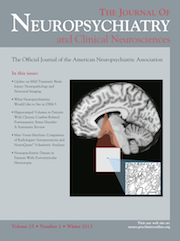A Case of Dual Dissociative and Re-Experiencing/Hyperarousal Subtypes in Childhood PTSD: A Neuropsychiatric Formulation
To the Editor: Posttraumatic stress disorder (PTSD) is characterized by re-experiencing phenomena, hyperarousal, avoidance, and emotional numbing after experiencing or witnessing life-endangering trauma. Trauma responses exhibit two hypothesized phenotypes: hyperarousal/re-experiencing and dissociative subtypes.1,2 We present an illustrative case and neuropsychiatric formulation of dual dissociative and nondissociative PTSD symptomatology.
Case Report
A 15-year-old, right-handed, Hispanic boy, adopted at age 4, with a history of attention-deficit/hyperactivity disorder (ADHD) admitted to a tertiary-care inpatient psychiatric service from an outside hospital after an approximately 30-minute episode of unresponsiveness. His vital signs showed a blood pressure of 131/78, heart rate of 66, and a glucose level of 100. His basic metabolic panel and toxicology screen were unrevealing. Upon waking, he reported 10 years of retrograde amnesia; he did not recognize his adoptive parents, failed to recall school events, and was surprised by his body habitus and physical abilities. His neuropsychiatric history included 2–3 months of recurrent, unresponsive, atonic events lasting minutes to hours. He was previously admitted for a neurological evaluation that showed normal brain magnetic resonance imaging, electroencephalography, electrocardiogram, and transthoracic echocardiogram. Preceding stressors included exposure to verbal aggression and physical discipline directed toward his biological sibling. Medications on admission included sertraline 50 mg, aripiprazole 10 mg, dexmethylphenidate extended-release preparation 20 mg, and trazodone 50 mg. Mental status exam revealed poor eye contact, constricted affect, feeling “weirded out,” and intermittent recollection of a blue house. Cognitive testing (limited by patient cooperation) revealed mild lethargy and disorientation to month, year, and date. He registered 3/3 words and recalled 1/3 in 5 minutes, with improvement to 2/3 on word choice. Elemental neurological exam was normal. His hospital course was notable for resolution of amnesia over the first week and daily intrusive recollections of being locked in a closet while living with his biological parents in a blue house; he had similarly-themed nightmares. Over a 6-week period, he exhibited multiple atonic, unresponsive events lasting 10–30 minutes, triggered by traumatic recollections, negative peer interactions, or other stressors. He also manifested emotionally-triggered hyperarousal episodes characterized by jaw clenching, fist clenching, attack-like posturing, diminished responsiveness to redirection, and hypervigilence, lasting 10–30 minutes. The patient received supportive psychotherapy, psychoeducation, and pharmacologic adjustments (sertraline 150 mg daily, aripiprazole and trazodone discontinued, prazosin 2 mg nightly for nightmares, risperidone 2 mg twice daily for hyperarousal/agitation) with diminished frequency of both subtypes. This case provides a within-subject example of dual dissociative (disruption and fragmentation of memory, identity, consciousness, and bodily awareness) and hyperarousal/re-experiencing PTSD subtypes. Pathological hyperarousal and re-experiencing phenomena have been linked to emotional undermodulation (impaired top-down inhibition) mediated by diminished rostral anterior cingulate cortex (ACC) and ventromedial prefrontal cortex (PFC) activity, and heighted amygdala activity.2,4 Dissociation has been associated with dorsal ACC and medial PFC hyperactivity (overmodulation) and posterior parietal cortex dysfunction.2,4 Finally, ACC dysfunction could provide an overlapping circuit-based explanation for the patient’s ADHD and PTSD diagnoses.5
1 : Acute and chronic responses to psychological trauma: where do we go from here? Am J Psychiatry 1999; 156:349–351Medline, Google Scholar
2 : Emotion modulation in PTSD: Clinical and neurobiological evidence for a dissociative subtype. Am J Psychiatry 2010; 167:640–647Crossref, Medline, Google Scholar
3 : Brain activation during script-driven, imagery-induced dissociative responses in PTSD: a functional magnetic resonance imaging investigation. Biol Psychiatry 2002; 52:305–311Crossref, Medline, Google Scholar
4 : Feeling unreal: a PET study of depersonalization disorder. Am J Psychiatry 2000; 157:1782–1788Crossref, Medline, Google Scholar
5 : Cingulate, frontal, and parietal cortical dysfunction in attention-deficit/hyperactivity disorder. Biol Psychiatry 2011; 69:1160–1167Crossref, Medline, Google Scholar



